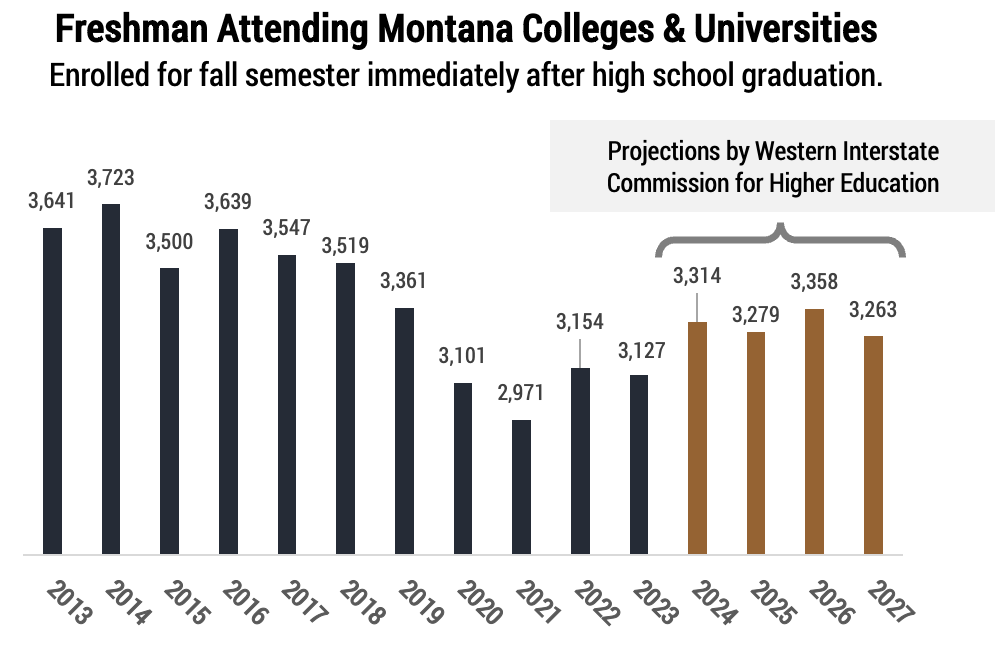What do the ACT scores and growth of the Montana Digital Academy tell us about the effectiveness of Montana’s public high schools?
The ACT scores among a majority of 11th grade Montanans are falling well below recommended benchmarks. Tens of thousands of students in grades 9-12 are taking digital coursework and catching up on missed credits so that they don’t have to take remedial college courses. We can only draw one conclusion from this evidence – most high schools are not preparing students for college success.
The Western Interstate Commission for Higher Education projects that 42,010 students will graduate from Montana high schools over the next four years. If current trends hold, between 20,580 and 13,500 of these students will fall well short of ACT benchmarks in Mathematics and/or English Language Arts.
This is not just a post-Pandemic problem. Statewide ACT scores declined across all areas between the 2016 and the 2019 school year, forcing tens of thousands of students to turn to Montana Digital Academy to be college ready. Montana high schools must recognize the persistent downward trends and take steps to fix these challenges.
One proposed solution is for district high schools to authorize new charter schools under House Bill 549. The Kalispell, Billings, Corvallis, Frenchtown, Hamilton, and Missoula school districts have each submitted applications for new or existing programs that focus on post-secondary or career tracks. However, as we discussed in our November article, these charter schools would fall under the same district leaders, educators, managerial norms, district policies, state department rules, and legislative regulations that are preventing Montana high schoolers from becoming college ready in the first place.
For example, in Frenchtown, 60% of students tested below the ACT benchmark in ELA and 77% below the Math benchmark. Yet the district is seeking approval for the Bronc Fast Track Public Charter, which would enable students to complete college credits and even earn associate degrees during high school. Should the same district that is not preparing 2 out of 3 students for college-level coursework start operating a charter school that awards college credits and two-year degrees?
In most states, the purpose in opening charter schools is to better meet students’ needs by introducing innovation, choice, competition, and accountability for results into public education. When we examine the research on charter schools, it is evident that student outcomes are getting stronger in many parts of the nation. Yet such positive change can only happen when there is the freedom for new leadership, innovative practices, and better choices to be implemented.
As we have demonstrated in this article, every year, thousands of Montana students deserve access to high schools that prepare them for college. Thus, there is a golden opportunity for charter schools to light the way by designing and delivering better options. The question is, how do we best blaze that trail without allowing the poor performance plaguing so many regular district high schools to become the norm among charter schools?
In 2009, it was necessary for the Montana legislature to authorize the Montana Digital Academy to begin to reduce Montana’s college remediation rates without continuing to rely on traditional district-run high schools alone. Today, Montana has an extraordinary opportunity to continue to fix this statewide problem by allowing new charter high schools to open. Yet we believe that opportunity can only be realized if new charter high schools can open outside the constraints preventing many district high schools from improving.
In our next article, we will continue our exploration of college and career readiness. Specifically, we will look at whether Montana high schools are equipping students with the knowledge, skills, and attributes to be successful in the workforce and contribute to Montana’s economic well-being and prosperity.

 In this 4th article in our 12-part series, the question we want to explore is how well Montana high schools are preparing graduating 12th graders for success in college.
In this 4th article in our 12-part series, the question we want to explore is how well Montana high schools are preparing graduating 12th graders for success in college.